| Ann. Medit. Burns Club - vol. VII - n. 3 - September 1994
NATURAL SKIN GRAFT EXPANSION: OUR EXPERIENCE WITH A
FOUR-MONTHS PREGNANT BURNED PATIENT
Caleff i E., Bocchi A., Toschi S., Papadia F.
Division of Plastic Surgery, University of Parma,
Italy
SUMMARY. Skin has the property of
stretchability in natural phenomena such as obesity and pregnancy but it can also be
contracted by wound healing or cutaneous grafts. On the basis of these considerations, the
case is reported of a four-months pregnant patient with abdominal bums. It is concluded
that natural expansion overcomes wound and graft contraction and produces better final
results in comparison to unexpanded cutaneous surfaces in the same patient or in another
patient in whom natural expansion does not occur.
Introduction
Skin expansion is one of the most
important innovations in plastic surgery, making it possible to increase reconstructive
possibilities in the event of wide losses of substance.
Our starting point was the observation of the stretching of skin, due to its elastic
properties, caused by obesity and pregnancy; while on the other hand we observed skin
contraction and reduction after wound heating and skin graft take.
When these two forces conflict, it is of clinical importance to evaluate whether the
retractile force overcomes, counterbalances or is inferior to skin expansion.
A clinical example is presented in a pregnant patient with second- and third- degree burns
of the trunk and inferior limbs admitted to our hospital and subjected to skin graft to
cover the raw areas.
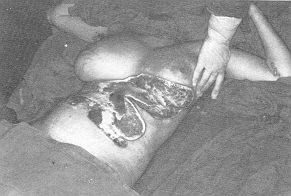 |
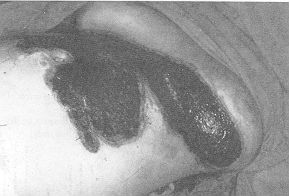 |
| Fig. 1 -
Pre-operative aspect (13 days after injury). |
Fig. 2 -
Pre-operative aspect after cleansing (23 days after injury). |
|
Case report
C.D.A., 30 years old, presented
second- and thirddegree burns in the thorax, left breast, adbomen and left thigh after a
car accident, when she was 16 weeks pregnant. She was admitted to our Burns Centre 13 days
after injury, coming from another hospital (Fig. 1).
Initially we performed local treatment of the burns with antibiotic products, chemical
escharotomy and partial escharectomy.
Twenty-three days after hospitalization (21st week of pregnancy) the patient was submitted
to total escharectomy and skin autografting. The grafts were removed from the thigh and
meshed 3: 1 (Fig. 2).
The post-operative course was good, with total graft take and rapid healing of donor
sites. The patient was discharged 35 days after hospitalization without local systemic or
gynaecological complications.
At first, dressings were performed on an out-patient basis once a week, and then every
15 days.
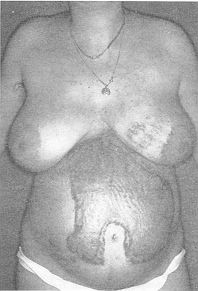 |
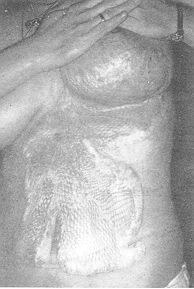 |
| Fig. 3 -
Post-operative aspect (4 months). |
Fig. 4 - Post-operative
aspect (1 year after delivery). |
|
Abdominal and breast grafts followed the physiological
stretching of pregnancy. These were translucent and hyperaemic (Fig. 3).
The patient bore her baby in June 1991 and further controls at our Centre were carried out
every two months until one year after delivery, showing a very satisfactory aspect of the
abdominal and breast grafted areas, which were soft, elastic and non-painful (Figs. 4,
5). The healing of the left thigh burned areas, even though quite satisfactory, was of
worse quality, with hypertrophic blushing and aching tissues (Fig. 6).
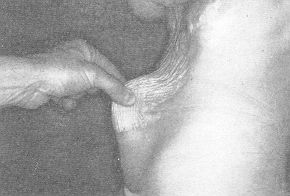 |
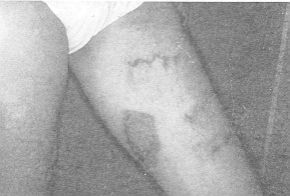 |
| Fig. 5 -
Post-operative profile aspect showing elasticity of skin and softness of graft (1 year
after delivery). |
Fig. 6 -
Post-operative aspect of left thigh (1 year after injury). |
|
Discussion
The.. homogeneous expansion of a skin
wound on the one hand allows a complete and more rapid re-epithelialization and on the
other leaves a scar of better quality, making an intrinsic compression.
The skin graft site permits the same considerations because its high tendency to
retraction shows the effectiveness,of the stretching mechanism even better.
Conclusion
When the natural expansion of raw or
healing skin surfaces is performed, the subsequent biological phenoiftena could have a
therapeutic significance, allowing a tissue repair of better quality because of the
stretching as opposed to wound contraction.
Natural skin expansion improved graft take (through local phlogosis and hyperaernia) and
stabilization, substituting post-operative compression and the daily application of zinc
oxide products.
The progressive increase of skin tension during natural expansion, as in the case we
report, therefore overcomes skin graft and scar retraction due to myofibroblasts.
RESUME. La peau a la propriété
de pouvoir s'étendre à cause de certains phénomènes naturels, comme l'obésité et la
grossesse. Cependant elle est aussi sujette à la contraction due à la guérison des
lésions ou aux greffes cutanées. Sur la base de ces considérations, les auteurs,:
après avoir décrit une patiente enceinte de 4 mois atteinte de brûlures abdominales,
concluent que l'expansion naturelle surmonte la contraction causée par les lésions ou
les greffes et produit des résultats finals supérieurs à ceux que l'on peut obtenir
avec les surfaces cutanées non étendues du même patient ou chez un autre patient qui ne
présente pas l'expansion naturelle.
BIBLIOGRAPHY
- Argenta L.C.: Controlled tissue expansion in
reconstructive surgery.Br. J. Plast. Surg., 37: 250,1984.
- Davis J.S., Kitlowsky E.A.: The immediate
contraction of cutaneous graft and its cause. Arch. Surg., 23: 954, 1931.
- Larson D.V., Abston-Willis B., Dobrokosky M., Evans
E.B., Lewiss R.: Contracture and scar formation in burn patients. Clin. Plast. Surg., I
~ 653, 1974.
- Marks MW., Argenta L.C., Thomton J.: Bum
management - the role of tissue expansion. Clin. Plast. Surg., 14: 543, 1987.
- Rudolph R., Guber S., Suzuky M., Woodward M.: The
life cycle of the myofibroblast. Surg. Gynecol. Obstet., 145: 954, 1977.
- Rudolph R., Guber S., Woodward M.: Inhibition of
myofibroblast by skin grafts. Plast. Reconstr. Surg., 63: 473, 1979.
|





